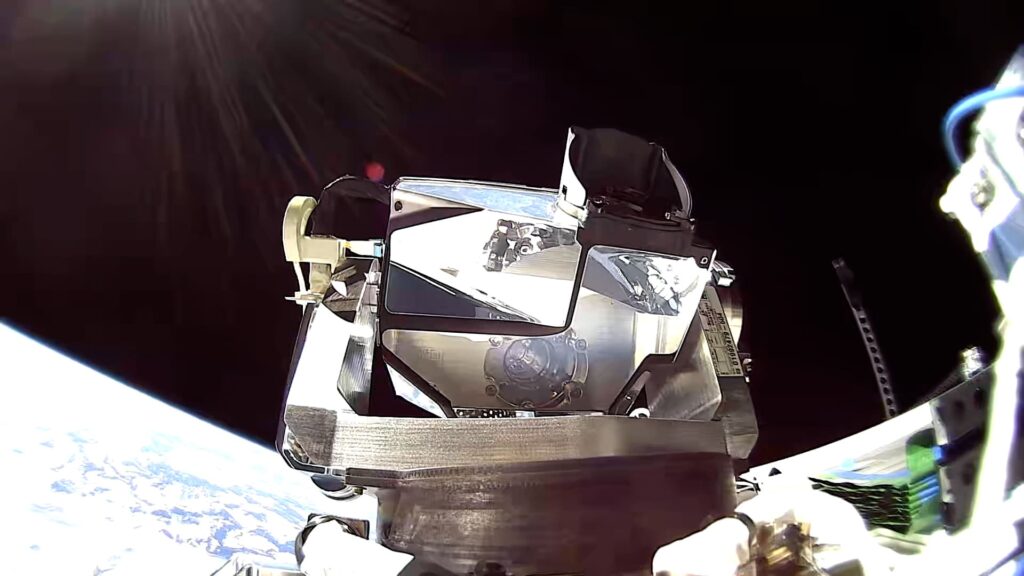Muon Space will integrate Starlink’s mini laser terminals into its Halo™ satellite platform, giving customer constellations persistent, high-throughput, low-latency connectivity in orbit. The deal effectively plugs Muon’s spacecraft into Starlink’s global optical mesh, enabling real-time tasking, continuous command-and-control, and high-bandwidth data streaming anywhere on Earth—without waiting for ground-station passes.
The headline specs
- 25 Gbps optical links per terminal at distances up to 4,000 km (higher rates at shorter range).
- Millisecond-class end-to-end latency from LEO to terrestrial points of presence via Starlink’s in-space relay.
- >99% uptime in multi-terminal configs using make-before-break handovers across relay satellites.
- Security by design: encrypted, mutually authenticated tunnels through Starlink’s network; hardware-anchored keys with customer-controlled end-to-end encryption layered on top.
Why it matters
Traditional LEO operations depend on intermittent ground contacts—brief windows that force batch downlinks, delayed tasking, and slow product delivery. With Starlink’s in-orbit optical backbone, Halo satellites become always-on network nodes. That shift compresses decision cycles from minutes to seconds, and turns space platforms into extensions of a distributed data center:
- Data-center-class pipelines: stream 25 Gbps persistently to cloud PoPs, while running edge processing (AI inference, fusion, product generation) on-orbit.
- Operational agility: immediate retasking, continuous payload ops, and closed-loop workflows (sense → decide → act) from space.
- Resilience: optical backhaul independent of local ground stations, with seamless handovers for high availability.
“With persistent optical broadband, Halo satellites move from isolated vehicles to real-time nodes,” said Muon’s CTO Pascal Stang. “It changes how missions are designed and how fast insights reach decision-makers.”
A concrete use case: wildfires in (near) real time
Muon highlights Earth Fire Alliance’s FireSat constellation for global wildfire detection. Integrating Starlink’s mini lasers is expected to cut FireSat’s average data latency from ~20 minutes to near real time. That means:
- Faster ignition alerts to incident commanders while fires are still small.
- Continuous perimeter updates and threat assessments throughout an event.
“FireSat is already a game-changer,” noted Earth Fire Alliance’s Brian Collins. “Starlink’s optical connectivity can shrink delivery timelines so responders act at the earliest stages—preventing more disaster-scale fires.”
Under the hood: Halo + Starlink
- Halo platform: Muon’s vertically integrated stack, built around the MuSat XL (≈500 kg class) bus with high-precision pointing and ample payload capacity, plus a software-defined orchestration layer for payload management and tasking.
- Starlink mini lasers: compact inter-satellite terminals that tie Halo spacecraft into Starlink’s on-orbit laser mesh and route traffic to terrestrial PoPs.
- Scalable uptime: single-terminal setups see brief hops during handovers; multi-terminal systems achieve make-before-break continuity.
“High-speed, low-latency in-orbit connectivity is foundational,” said SpaceX’s Michael Nicolls. “With mini lasers, Muon’s spacecraft stay persistently connected through our laser mesh for real-time operations and immediate data delivery.”
Timeline and availability
- Integration underway on current customer constellations.
- First Starlink-enabled Halo launch planned for Q1 2027.
Industry context: from passes to presence
The move underscores a broader transition in LEO: from pass-based architectures (limited visibility, delayed delivery) to network-native spacecraft that behave like always-connected edge nodes. For commercial Earth observation, climate analytics, and national security missions, the payoff is faster time-to-insight, more responsive tasking, and simpler global operations—without building bespoke ground networks in every region.
What to watch next
- Throughput at scale: how persistent 25 Gbps pipelines per satellite translate to fleet-wide daily data volumes and cloud egress economics.
- Edge-to-cloud workloads: real deployments of on-orbit AI/ML and closed-loop tasking (e.g., cue, collect, process, deliver).
- Multi-link reliability: empirical uptime from make-before-break handovers across varied orbital geometries.
- Security posture: adoption of customer-controlled encryption and key management for sensitive missions.
Muon’s bet is clear: spacecraft as first-class Internet nodes—and space data that moves at the speed of the cloud.
vía: Muon Space

